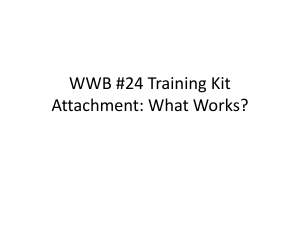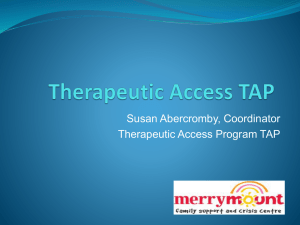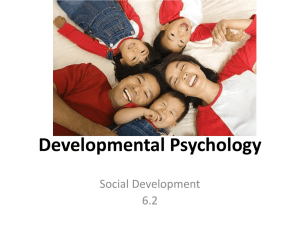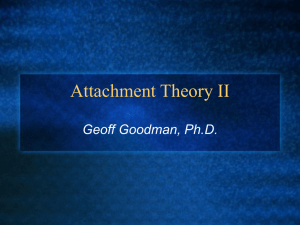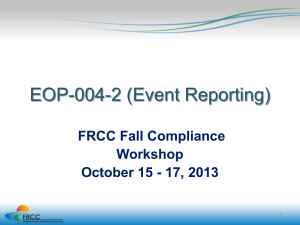An Introduction to Adult Attachment
advertisement
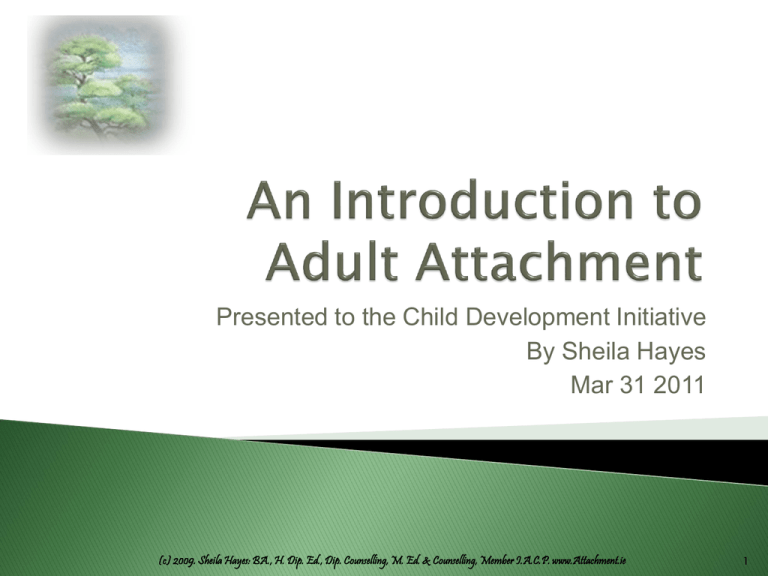
Presented to the Child Development Initiative By Sheila Hayes Mar 31 2011 (c) 2009. Sheila Hayes: BA., H. Dip. Ed., Dip. Counselling, M. Ed. & Counselling, Member I.A.C.P. www.Attachment.ie 1 Clinical Counsellor since 1996 Member IACP Masters in Educational Guidance and Counselling from Trinity College ◦ Masters Dissertation on Attachment Theory (c) 2011. Sheila Hayes: www.Attachment.ie 2 Ursula ◦ May have harsh unmodulated voice timbres, at variance with an imploring or pleading look in their eyes. ◦ Beneath a self – sufficiency is a desire to be looked after. ◦ In essence all container and no feelings Cliona ◦ The tone of voice is often rambling and monotonous and find it hard to come to the point and to shape their story. ◦ Conversation is an attempt to maintain contact rather than to create dialogue. ◦ Beneath the clinging behaviour is rage and narcissism and a huge fear of losing the secure base. ◦ In essence all feelings and no where to contain them. Nick ◦ ◦ ◦ ◦ Huge trust issues, Extremely sensitive ‘Narcissistic’ needs, Anxiety around rejection, control, ridicule and bullying (All References Holmes, J., 2001) (c) 2011. Sheila Hayes: www.Attachment.ie 3 Review of Infant Attachment ◦ John Bowlby and the 1957 Paper ◦ Elements of Attachment Relationships ◦ Mary Ainsworth and the Strange Situation Development of the Adult Attachment Interview Attachment Styles Implications and uses of Adult Attachment ◦ Intergenerational Transmission of Attachment Styles ◦ Couple Love ◦ Attachment Theory effect on Mental Health Using Attachment Theory in Therapy Resources & References Questions (c) 2011. Sheila Hayes: www.Attachment.ie 4 Has always been a key question in Psychoanalysis (c) 2011. Sheila Hayes: www.Attachment.ie 5 Developed the Oedipus Complex Maintained Psychological problems arose as a result of lack of resolution of the Oedipus Complex. (c) 2011. Sheila Hayes: www.Attachment.ie 6 Mother Child bond arose due to feeding ◦ Kleinian Dependency Theory Psychological problems arose ◦ Not from lack of resolution of the Oedipus Complex ◦ But from the act of weaning The Freud / Klein view of the Mother-Child relationship was predominant up to the 1960s (c) 2011. Sheila Hayes: www.Attachment.ie 7 Konrad Lorenz Studied goslings and ducklings who fed themselves Proposed that a bond could develop without the intermediary of food. Developed the term Imprinting ◦ Where a duckling or gosling can attach itself to almost anything (such as a Wellington boot) Received a Nobel prize in 1973 (c) 2011. Sheila Hayes: www.Attachment.ie 8 Review of Infant Attachment ◦ John Bowlby and the 1957 Paper ◦ Elements of Attachment Relationships ◦ Mary Ainsworth and the Strange Situation Development of the Adult Attachment Interview Attachment Styles Implications and uses of Adult Attachment ◦ Intergenerational Transmission of Attachment Styles ◦ Couple Love ◦ Attachment Theory effect on Mental Health Using Attachment Theory in Therapy Resources & References Questions (c) 2011. Sheila Hayes: www.Attachment.ie 9 “The Nature of the Child’s Tie to his Mother” ◦ A child’s psychological wellbeing is heavily influenced by its relationship to its Mother and Wider Environment. ◦ To address psychopathologies, these relationship have to be addressed This paper is the foundation stone of what became attachment theory (c) 2011. Sheila Hayes: www.Attachment.ie 10 It was dominated by the Freud / Klein View Uproar ◦ Received very critically ◦ He left the society Was unable to effect change in how children were treated in hospitals due to opposition (c) 2011. Sheila Hayes: www.Attachment.ie 11 Review of Infant Attachment ◦ John Bowlby and the 1957 Paper ◦ Elements of Attachment Relationships ◦ Mary Ainsworth and the Strange Situation Development of the Adult Attachment Interview Attachment Styles Implications and uses of Adult Attachment ◦ Intergenerational Transmission of Attachment Styles ◦ Couple Love ◦ Attachment Theory effect on Mental Health Using Attachment Theory in Therapy Resources Questions References (c) 2011. Sheila Hayes: www.Attachment.ie 12 Features of a healthy attachment relationship ◦ Secure Base ◦ Safe Haven ◦ Proximity Maintenance ◦ Separation Distress See Circle of Security (c) 2011. Sheila Hayes: www.Attachment.ie 13 (c) 2011. Sheila Hayes: www.Attachment.ie 14 Bowlby stated that even if there is a long separation between the child and the mother after the bond has been formed, the bond will still be there and be recognisable in the child’s behaviour towards the mother. (c) 2011. Sheila Hayes: www.Attachment.ie 15 A child has two unconscious working models (or mental maps). They govern ◦ How the child views himself ◦ How he views the world Development of the working models is determined by the attachment relationship with his primary carer Models can be ◦ Positive ◦ Negative ◦ Multiple / Conflicting (c) 2011. Sheila Hayes: www.Attachment.ie 16 Bowlby maintained these were at the roof of Psychopathologies. e.g. I’m afraid Dad will leave and I hope Dad will leave Bowlby posited that conflicting working models were at the root of intergenerational Transmission of Neurosis. (c) 2011. Sheila Hayes: www.Attachment.ie 17 Review of Infant Attachment ◦ John Bowlby and the 1957 Paper ◦ Elements of Attachment Relationships ◦ Mary Ainsworth and the Strange Situation Development of the Adult Attachment Interview Attachment Styles Implications and uses of Adult Attachment ◦ Intergenerational Transmission of Attachment Styles ◦ Couple Love ◦ Attachment Theory effect on Mental Health Using Attachment Theory in Therapy Resources & References Questions (c) 2011. Sheila Hayes: www.Attachment.ie 18 Child’s Chair Heaped with Toys Stranger’s Chair (c) 2011. Sheila Hayes: www.Attachment.ie Mother’s Chair 19 Originally conducted in 1968 in Baltimore USA 100 Middle class children Defined protocol (c) 2011. Sheila Hayes: www.Attachment.ie 20 (c) 2011. Sheila Hayes: www.Attachment.ie 21 Identified Attachment styles ◦ One Secure ◦ Two Insecure ◦ One Uncategorised (13%) Results have been replicated in dozens of studies around the world since (c) 2011. Sheila Hayes: www.Attachment.ie 22 Review of Infant Attachment ◦ John Bowlby and the 1957 Paper ◦ Elements of Attachment Relationships ◦ Mary Ainsworth and the Strange Situation Development of the Adult Attachment Interview Attachment Styles Implications and uses of Adult Attachment ◦ Intergenerational Transmission of Attachment Styles ◦ Couple Love ◦ Attachment Theory effect on Mental Health Using Attachment Theory in Therapy Resources & References Questions (c) 2011. Sheila Hayes: www.Attachment.ie 23 Little known about it or whether attachment existed into adulthood Adult attachment seen as more complex and difficult to measure Thinking was that couples had to be studied Realised that much of adult relationships exist in the mind ◦ In how they think and feel about relationships A lot of their relationships are invisible to an outsider (c) 2011. Sheila Hayes: www.Attachment.ie 24 Follow up longitudinal study in from 1979 to 1985 Berkeley to see the effect that parents had on the Strange Situation Mary Main believed that earlier experiences do not just shape later behaviours they also shape a person’s beliefs and expectations about relationships Developed the Adult Attachment Interview protocol Identified four attachment styles ◦ One secure ◦ Three Insecure The adult styles were similar to the child styles. (c) 2011. Sheila Hayes: www.Attachment.ie 25 I'd like you to try to describe your relationship with your parents as a young child if you could start from as far back as you can remember? ◦ Encourage participants to try to begin by remembering very early. Many say they cannot remember early childhood, ◦ but you should shape the questions such that they focus at first around age five or earlier, and gently remind ◦ the research participant from time to time that if possible, you would like her to think back to this age period. ◦ Admittedly, this is leaping right into it, and the participant may stumble. If necessary, indicate in some way that ◦ experiencing some difficulty in initially attempting to respond to this question is natural, but indicate by some ◦ silence that you would nonetheless like the participant to attempt a general description. (c) 2011. Sheila Hayes: www.Attachment.ie 26 Now I'd like to ask you to choose five adjectives or words that reflect your relationship with your mother starting from as far back as you can remember in early childhood--as early as you can go, but say, age 5 to 12 is fine. I know this may take a bit of time, so go ahead and think for a minute...then I'd like to ask you why you chose them. I'll write each one down as you give them to me. (c) 2011. Sheila Hayes: www.Attachment.ie 27 Did you ever feel rejected as a young child? Of course, looking back on it now, you may realise it wasn't really rejection, but what I'm trying to ask about here is whether you remember ever having being rejected in childhood (c) 2011. Sheila Hayes: www.Attachment.ie 28 AAI assesses a person’s “state of mind with respect to attachment” and not whether a person is “securely attached” to a second person The narrative is examined for material purposely expressed by the individual and for material the individual is unaware of ◦ e.g., apparent incoherence and inconsistencies of discourse thereby aiming to assess elements of the attachment representation which are not conscious (working models are in the unconscious) How the narrative is reported is as important as the narrative itself as it reflects the state of mind with respect to attachment( the AAI picks up on how we perceive relationships based on own attachment experience) The AAI is scored based on ◦ Descriptions of childhood experiences ◦ Language used in the interview ◦ The ability to give an integrated, believable account of experience and their meaning (c) 2011. Sheila Hayes: www.Attachment.ie 29 Adults assessed via the AAI are not considered securely versus insecurely attached, but rather as being in a secure state of mind with respect to attachment One person conducts and transcribes Second person scores based purely on the written transcript. (c) 2011. Sheila Hayes: www.Attachment.ie 30 Review of Infant Attachment ◦ John Bowlby and the 1957 Paper ◦ Elements of Attachment Relationships ◦ Mary Ainsworth and the Strange Situation Development of the Adult Attachment Interview Attachment Styles Implications and uses of Adult Attachment ◦ Intergenerational Transmission of Attachment Styles ◦ Couple Love ◦ Attachment Theory effect on Mental Health Using Attachment Theory in Therapy Resources & References Questions (c) 2011. Sheila Hayes: www.Attachment.ie 31 Adult State of Mind With Respect To Attachment Secure/Autonomous Coherent collaborative discourse. Valuing of attachment, but seems objective regarding any particular event or relationship. Description and evaluation of attachment-related experience is consistent, whether experiences are favourable or unfavourable. (c) 2011. Sheila Hayes: www.Attachment.ie Infant Strange Situation Behaviour Secure Explores room and toys with interest in preseparation episodes. Show signs of missing parent during separation, often crying by second separation. Obvious preference for parent over stranger. Greets parent actively, usually initiating physical contact. 32 Adult State of Mind With Respect To Attachment Dismissing Not coherent. Dismissing of attachment related experiences and relationships. Normalising (“excellent, very normal mother”), with generalised representations of history unsupported or actively contradicted by episodes recounted. Transcripts also tend to be excessively brief. (c) 2011. Sheila Hayes: www.Attachment.ie Infant Strange Situation Behaviour Avoidant Fails to cry on separation from parent. Actively avoids and ignores parent on reunion (i.e. by moving away, turning away, or leaning our arms when picked up). Little or no proximity seeking, no distress and no anger. Response to parent seems unemotional. Focuses on toys or environment throughout the process. 33 Adult State of Mind With Respect To Attachment Preoccupied Not coherent. Preoccupied by past attachment relationships/experiences, speaker appears angry, passive or fearful. Sentences often long, grammatically entangled or filled with vague usages (“dada,” “and that”). Transcripts often excessively long. (c) 2011. Sheila Hayes: www.Attachment.ie Infant Strange Situation Behaviour Resistant or ambivalent May be wary or distressed prior to separation, with little exploration. Preoccupied with parent throughout procedure; may seem angry or passive. Fails to settle and take comfort in parent on reunion, and usually continues to focus on parent and cry. Fails to return to exploration after reunion. 34 Adult State of Mind With Respect To Attachment Infant Strange Situation Behaviour Unresolved/disorganised During discussions of loss or abuse, individuals show striking lapse in the monitoring or reasoning or discourse. For example, individual may briefly indicate a belief that a dead person is still alive in the physical sense, or that this person was killed by a childhood thought. Individual may lapse into prolonged silence or eulogistic speech. Disorganised/disorientated The infant displays disorganised and/or disoriented behaviours in the parent’s presence, suggesting a temporary collapse of behavioural strategy. For example, the infant may freeze with a trance-like expression, hands in air; may rise at parent’s entrance, then fall prone and huddled on the floor; or may cling while crying and leaning away with gaze averted. This work classified the third insecure style for children as verbal responses of parents matched the behavioural responses of the children in the unclassified 13% (c) 2011. Sheila Hayes: www.Attachment.ie 35 Secure people are able to talk coherently about their earlier experience even though that experience was negative, they have integrated the events with the feelings of that period – have insight and ability to reflect (the main aim of therapy is to help a person get insight to their experience so integration can occur) Ability to engage in meta cognition or to see one’s situation objectively distinguishes secure from insecure attachment experiences (c) 2011. Sheila Hayes: www.Attachment.ie 36 Review of Infant Attachment ◦ John Bowlby and the 1957 Paper ◦ Elements of Attachment Relationships ◦ Mary Ainsworth and the Strange Situation Development of the Adult Attachment Interview Attachment Styles Implications and uses of Adult Attachment ◦ Intergenerational Transmission of Attachment Styles ◦ Couple Love ◦ Attachment Theory effect on Mental Health Using Attachment Theory in Therapy Resources & References Questions (c) 2011. Sheila Hayes: www.Attachment.ie 37 The AAI is the only measure which has been used to examine intergenerational transmission of attachment and the relations between adult attachment status, parenting behaviour and child outcome Investigations of parental attachment classification and infant Strange Situation find 80% correspondence Parent – child studies in infancy: comparison of kibbutz – reared infants who slept at home with their parents, and those who slept communally found 76% correspondence between maternal AAI and child Strange Situation for the home based dyads versus 40% for communal dyads (Sagi, Aviezer et al., 1992) Parent – child studies at school age: Mothers classified as secure were warmer, more supportive, and smoother in transitioning between activities than insecure mothers. Mothers classified as dismissing were more abrupt in transitioning between activities than preoccupied mothers. Observed child behaviour did not differ with respect to maternal classification. However, ratings of behaviour and affective symptoms by parents, teachers and the children revealed children of dismissing mothers had the highest levels of pathology. (c) 2011. Sheila Hayes: www.Attachment.ie (Crowell, O’ Connor, Wollmers, Sprafkin, & Rao, 1991) 38 Parental security of attachment was associated with parents providing structure during the tasks Secure fathers were warmer towards their preschoolers (Cohn, Cowan, Cowan, & Pearson, 1992a) Couples’ concordance for AAI and parenting style was also examined: insecure women married to insecure men were not as warm with their children as insecure women married to secure men. There was no difference between secure and insecure mothers who were married to secure men. Spousal support may be helpful to ‘insecure’ mothers in interactions with their children. (c) 2011. Sheila Hayes: www.Attachment.ie 39 Review of Infant Attachment ◦ John Bowlby and the 1957 Paper ◦ Elements of Attachment Relationships ◦ Mary Ainsworth and the Strange Situation Development of the Adult Attachment Interview Attachment Styles Implications and uses of Adult Attachment ◦ Intergenerational Transmission of Attachment Styles ◦ Couple Love ◦ Attachment Theory effect on Mental Health Using Attachment Theory in Therapy Resources & References Questions (c) 2011. Sheila Hayes: www.Attachment.ie 40 In 1987 Hazen & Shaver produced a seminal study on romantic love Pair - bond /romantic relationships assume the role of attachment figures in adult life where the partner becomes the secure base There are four defining features of attachment bonds: proximity maintenance, separation distress, safe haven and secure base Attachment in early life is asymmetrical - infants seek and derive security from care givers but do not give it in return, in pair bonds the care giving is reciprocal (c) 2011. Sheila Hayes: www.Attachment.ie 41 Striking similarities in the physical intimacy and prolonged face to face contact between infant and caregiver and in adult romantic partners In almost every culture these intimate interpersonal exchanges are limited to parent – infant and pair bond relationships (Eibl – Eibesfeld, 1975). (c) 2011. Sheila Hayes: www.Attachment.ie 42 Bowlby noticed that separated children who were well cared for physically, showed striking similarities in how they responded to separation There was a universal pattern of behaviour which he referred to as the “protest-despair-detachment” sequence The same sequence of events can be seen in adults grieving for the loss of a spouse (including relationship breakups): ◦ Initial anxiety and panic, followed by lethargy and depression and eventually by recovery through emotional detachment (Hazen & Shaver, 1992; Parkes & Weiss, 1983; Weiss, 1975) ◦ The loss is integrated in the inner world of the bereaved Couples grieving for the loss of a child inevitably cannot provide a secure base for the other as each are overcome with grief. ◦ This is one reason why divorce rates are so high after such a tragedy (c) 2011. Sheila Hayes: www.Attachment.ie (Holmes, J., 2001) 43 Secure men engage in more positive and supportive interactions with their spouses than do insecure men (Cohn, Cowan, Cowan, & Pearson, 1992b; Ewing & Pratt, 1995; Kobak & Hazen, 1992). Secure college females in a stressful situation sought and accepted more physical and emotional support from their partners than insecure women (Simpson, Rholes, and Nelligan (1992) Perhaps because secure men are disproportionately likely to be partners of secure women (van Ijzendoorn & Bakermans – Kranenburg, 1996) Secure men are more likely to be concerned for their partners’ well being and to provide more emotional support then insecure men (c) 2011. Sheila Hayes: www.Attachment.ie 44 Where both partners were insecure there was more conflict (Cohn et al. 1992b) Lower levels of conflict and mutually focussed strategies for managing conflict are found in secure individuals (Pistole, 1989) Security in the relationship sets the stage for the development of a mutually rewarding relationships as each partner can venture out from the relationship and return back to the safe haven (c) 2011. Sheila Hayes: www.Attachment.ie 45 Working Models affect romantic relationships in the following way: Individuals tend to select environments that fit their beliefs about self and others ◦ e.g. A Preoccupied (Resistant or Ambivalent in infants) female and a Dismissing (Avoidant in infants) male are quite stable although not very happy. ◦ The clingy anxious behaviour of the Preoccupied female confirms the Dismissing male’s belief that it is unwise to let others get too close, ◦ The Dismissing male confirms the Preoccupied female’s belief that others are less concerned about love relationships than she is. (c) 2011. Sheila Hayes: www.Attachment.ie 46 Review of Infant Attachment ◦ John Bowlby and the 1957 Paper ◦ Elements of Attachment Relationships ◦ Mary Ainsworth and the Strange Situation Development of the Adult Attachment Interview Attachment Styles Implications and uses of Adult Attachment ◦ Intergenerational Transmission of Attachment Styles ◦ Couple Love ◦ Attachment Theory effect on Mental Health Using Attachment Theory in Therapy Resources & References Questions (c) 2011. Sheila Hayes: www.Attachment.ie 47 Secure ◦ People can draw on support from another person(s) via the secure base and talk coherently about the issue Insecure - Dismissing (Avoidant in infants) ◦ People will stay near to a protective one, but not too near for fear of rejection or aggression ◦ Intimacy is sacrificed in order that the affect is deactivated Insecure - Preoccupied (Resistant or Ambivalent in infants) ◦ People have been subjected to inconsistent responses when distressed and so cling to the care-giver even when no danger is present ◦ There is hyper activation of responses and exploration and autonomy are jettisoned in return for security Insecure - Unresolved / Disorganised (Disorganised / Disoriented in infants) ◦ Unresolved attachments have no coherent response for self protection ◦ Resort to defensive methods such as splitting, dissociation, role reversal and excessive controllingness Most patients with severe personality disorder show insecure patterns of attachment in the AAI (c) 2011. Sheila Hayes: www.Attachment.ie (J Holmes, 2001) 48 Securely attached individuals can deal with negative affect Insecure - Dismissing (Avoidant in infants) ◦ In the Dismissing, self esteem is short- circuited within the self. ◦ External validation has little impact, ◦ Will do his best to be in control and to keep intimacy at bay as it threatens his self containing system of maintaining self-esteem Insecure - Preoccupied (Resistant or Ambivalent in infants) ◦ The Preoccupied depend on the proximity and the positive regard of the clung to figure, if they are critical or lost the Preoccupied will suffer Insecure - Unresolved / Disorganised (Disorganised / Disoriented in infants) ◦ The Unresolved will try to control the care – giver In the case of a couple who are both securely attached, this leads to the development of a ‘third element’ which provides far greater security than each member of the couple can achieve on their own ◦ This is the relationship itself and the pattern of mutual expectations that it implies (c) 2011. Sheila Hayes: www.Attachment.ie 49 Review of Infant Attachment ◦ John Bowlby and the 1957 Paper ◦ Elements of Attachment Relationships ◦ Mary Ainsworth and the Strange Situation Development of the Adult Attachment Interview Attachment Styles Implications and uses of Adult Attachment ◦ Intergenerational Transmission of Attachment Styles ◦ Couple Love ◦ Attachment Theory effect on Mental Health Using Attachment Theory in Therapy Resources & References Questions (c) 2011. Sheila Hayes: www.Attachment.ie 50 Freud’s (1912) ‘fundamental rule’ ◦ Say what ever comes into your mind however impolite, irrelevant or embarrassing’ ◦ ‘if I could do that I wouldn’t need to be here in the first place’. (c) 2011. Sheila Hayes: www.Attachment.ie 51 Previous Statement summarises the mutual incompatibility of insecurity and exploration ◦ If some one is very insecure, they cannot examine their insecurities The aim of Attachment informed psychotherapy is to assist a client feel secure enough so that they can begin to explore ◦ Themselves ◦ Their life experiences and ◦ Their feelings – especially negative ones. (c) 2011. Sheila Hayes: www.Attachment.ie 52 The aim of attachment – based therapy is to help bring a client into a balanced position with regard to themselves and the world Clients seeking therapy fluctuate between the fear of aloneness and at the same time the terror of intimacy The therapist becomes the secure base providing security, consistency, reliability, responsiveness, warmth and firm boundaries It is hoped that through this environment the client can begin to trust and explore their relationships The client can internalise this ‘secure base’ and draw on it as a source of support after therapy (c) 2011. Sheila Hayes: www.Attachment.ie 53 Ursula: Insecure – Dismissing (Avoidant in infants) ◦ May have harsh unmodulated voice timbres, at variance with an imploring or pleading look in their eyes. ◦ Beneath a self – sufficiency is a desire to be looked after. ◦ In essence all container and no feelings Cliona: insecure – Preoccupied (Resistant or Ambivalent in infants) ◦ The tone of voice is often rambling and monotonous and find it hard to come to the point and to shape their story. ◦ Conversation is an attempt to maintain contact rather than to create dialogue. ◦ Beneath the clinging behaviour is rage and a huge fear of losing the secure base. ◦ In essence all feelings and no where to contain them. Nick: Insecure – Unresolved / Disorganised (Disorganised / Disoriented in infants) ◦ ◦ ◦ ◦ Huge trust issues, Extremely sensitive ‘Narcissistic’ defenses Anxiety around rejection, control, ridicule and bullying (All References Holmes, J., 2001) (c) 2011. Sheila Hayes: www.Attachment.ie 54 Insecure – Dismissing (Avoidant in infants) ◦ To provide the space which fosters attunement of feeling for Insecure – Preoccupied (Resistant or Ambivalent in infants) ◦ To provide the space secure enough to cope with relevant protest and where new meanings and secure narratives can arise Insecure – Unresolved / Disorganised (Disorganised / Disoriented in infants) ◦ To provide the safe space where emotions can be contained, beliefs challenged, and links made (c) 2011. Sheila Hayes: www.Attachment.ie 55 Review of Infant Attachment ◦ John Bowlby and the 1957 Paper ◦ Elements of Attachment Relationships ◦ Mary Ainsworth and the Strange Situation Development of the Adult Attachment Interview Attachment Styles Implications and uses of Adult Attachment ◦ Intergenerational Transmission of Attachment Styles ◦ Couple Love ◦ Attachment Theory effect on Mental Health Using Attachment Theory in Therapy Resources & References Questions (c) 2011. Sheila Hayes: www.Attachment.ie 56 www.attachment.ie ◦ My website ◦ This presentation can be downloaded ◦ Other resources and videos www.johnbowbly.com ◦ State University of New York at Stonybrook www.circleofsecurity.org ◦ Background and material on the Circle of Security (c) 2011. Sheila Hayes: www.Attachment.ie 57 Hazen, C., &Shaver, P. R. (1992). Broken attachments. In T. L. Orbuch (Ed.), Close relationship loss: Theoretical approaches (pp. 90-108). Hillsdale, NJ: Erlbaum. Bowlbys Three Books 1969: Attachment, ◦ (Updated 1982) 1972: Separation: Anxiety and Anger 1980: Loss: Sadness and Depression Cassidy, J. & Shaver, P. R. Handbook of Attachment Theory. Research and Clinical Applications. The Guildford Press. 1999. New York. Cohn, D., Cowan, P., Cowan, C., & Pearson, J. (1992a). Mothers’ and fathers’ working models of childhood attachment relationships, parenting style, and child behaviour. Development and Psychopathology, 4, 417-431. Cohn, D., Cowan, P., Cowan, C., &Pearson, J. (1992b). Working models of childhood attachment and couples relationships. Journal of Family Issues, 13, 432-449. Crowell, J., O’ Connor, E., Wollmers, G., Sprafkin, J., & Rao, U. (1991). Mothers’ conceptualisations of parent – child relationships: Relation to mother-child interaction and child behaviour problems. Development and Psychopathology, 3, 431-444 Ewing, K., Pratt, M. (1995, March). The role of adult romantic attachment in martial communication and parenting stress. Poster presented at teh biennial meeting of the Society for Research in Child Development, Indianapolis, IN. Feeney , J. A., & Noller, P. (1991). Attachment style and verbal descriptions of romantic partners. Journal of Social and Personal Relationships, 8, 187-215. Holmes, J, The Search for the Secure Base. Attachment Theory and Psychotherapy. Routledge 2001, East Sussex. Holmes, J, Exploring in Security. Towards and Attachment Influenced Psychoanalytic Psychotherapy. Routledge 2010, East Sussex. Simpson, J., Rholes, W., & Nelligan, J. (1992). Support seeking and support giving within couples in an anxiety-provoking situation: The role of attachment styles. Journal of Personality and Social Psychology, 62, 434-446. Main, M., (1995) recent studies in attachment; overview with selected implications for clinical work. In S. Goldberg, R. Muir and J. kerr (eds) Attachment Theory: Social Developmental and Clinical Perspectives. Hillsdale, NJ: Analytic Press. Parkes, C. M., & Weiss, R. S. (1983). Recovery from bereavement. New York: Basic Books. Pistole, M. (1989). Attachment in adult romantic relationships: Styles of conflict resolution and relationship satisfaction. Journal of Social and Personal Relationships, 6, 505-510. Sagi, A., van IJzendoorn, M., Koren – Karie, N., Joels, T., & Mayseless, O. (19940. Stability and discriminant validity of the adult attachment Interview: A psychometric study in young Isreali adults. Developmental Psychology, 30(5), 771 – 777 (c) 2011. Sheila Hayes: www.Attachment.ie Weiss, R. S. (1975). Martial separation. New York: Basic Books. Van IJzendoorn, M., Bakermans-Kranenburg, M. (1996). Attachment representation in mothers, fathers, adolescents, and clinical groups: A meta-analytic search for normative data. Journal of 58 Clinical and Consulting Psychology, 64, 8-21. (c) 2009. Sheila Hayes: BA., H. Dip. Ed., Dip. Counselling, M. Ed. & Counselling, Member I.A.C.P. www.Attachment.ie 59

